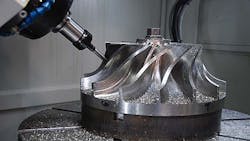5 Reasons a 5-Axis CNC Machine is Actually Good for Your Shop
The 5-axis CNC machine tool is a mainstay on many manufacturing plants and shop floors. While these systems once were reserved for undertaking complicated and specialized applications, large and small manufacturers now realize the value in using a 5-axis machine for every project. Many of them have been able to minimize lead times, bolster efficiency, and improve profitability as a result. These are some of the factors guiding their decisions:
1. Save time — One of the most obvious advantages of a 5-axis CNC mill is the reduction in time it takes to complete a project. Whereas a standard 3-axis machine might require several different set-ups and more than five hours to complete, its 5-axis counterpart can complete the part in just a couple operations that take less than two hours from start to finish.
There are two types of 5-axis machining: 5-sided, sometimes called 3+2 machining, and simultaneous 5-axis. Both methods are faster than traditional 3-axis machining, but 5-sided machining is much quicker and easier to program. Simultaneous 5-axis machining ultimately results in a smoother surface finish, according to experts, which is typically required to compete for projects with many aerospace applications.
2. Reduce cost per part — You can also reduce the overall production cost per part by using 5-axis machining. Because traditional 3-axis machines are able to work only on one side of a part at a time, those parts that require multiple finished sides require recalibration and, in some cases, reprogramming. All of this increases overall production time and labor, which all ties into the final product costs.
3. Improve molding — Molds made from liquid silicone rubber (LSR) or similar substances, are becoming increasingly complex. This is a result of design developments in some industries, such as the medical device manufacturing, that call for increased versatility in their new products. To accommodate this, many manufacturers are making the transition to 5-axis machines. Mold producers of nearly every specialization now realize the value in using advanced equipment for their needs.
While 3-axis machines will suffice for milling simple molds, these units might not even be able to handle some of the more complex designs seen in products today. They're simply not accurate or fast enough to meet the evolving and stringent industry standards. Projects like this specifically call for the use of a modern 5-axis mill.
4. Compatible with CAD / CAM — The technologies behind computer-aided design and computer-aided manufacturing have advanced by leaps and bounds over the past decade or two. Whereas once there had been limited software support available for 5-axis machines, nearly all of the most popular CAM software developers have upgraded their products to accommodate the additional two axes. Autodesk's Fusion 360 is an excellent example of how software programmers are implementing support for 5-axis mills. The Ultimate Version of Fusion 360 represents the first time the developer has provided native support for 5-axis machining in its software, but it certainly won't be the last.
5. Suitable for general and special projects —Some manufacturers and machine shops operate are under the impression that 5-axis machines are solely for special projects or highly complicated parts. While they can make short work of complex pieces, it's not their only application. Like their more traditional CNC machines, 5-axis mills also excel at simple parts and pieces that require minimal work.
Due to the high speed and efficiency of the newer hardware, manufacturers from all over the world are upgrading their traditional, 3-axis machines with 5-axis replacements. Best of all, they're already experiencing shorter lead times, greater quality control and greater profitability across the board.
Although they remain costly in terms of capital investment, 5-axis machine tools offer the opportunity to save a lot of set-up and production time and cost that will speed the return on investments, so that the transition to a 5-axis machine can be completed as soon as possible. It's not a process that needs to happen overnight; there's still some time left to get an edge over your competitors. For manufacturer or machine shop that wants to optimize production times and maximize profits, the upgrade should be made sooner rather than later.
About the Author
Megan R. Nichols
STEM writer and blogger
Megan Nichols is a STEM writer and blogger covering a wide range of scientific topics at schooledbyscience.com

